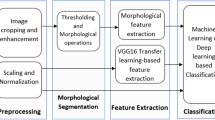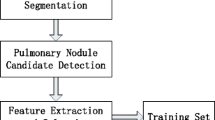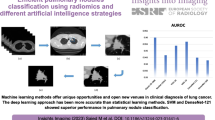Abstract
Lung cancers are not only affecting the lung but also impair the respiratory mechanism. Worldwide, it becomes one of the high causes of mortality in humans. Several computer aided diagnosis (CAD) systems have been designed in recent years for diagnosis of several diseases. Early detection of lung cancer has become very important which can enhance survival chances among humans. The average rates of survival people with lung-cancer can rise from 14 to 49 percent if the diagnosed is taking place in time. Compare to X-ray, computed tomography (CT) is more operative as it involves multiple imaging approaches to support each other. In this study, we have used lung-patient CT scan images to classify the lung nodule into four classes, which are small-cell-carcinoma, adenocarcinoma, squamous-cell-carcinoma and large-cell-carcinoma. This study has proposed VGG networks integrated with support vector machine and random forest to create a hybrid algorithm that further helps in reducing computation complexity of classification. The lung nodules are classified using these hybrids algorithms with highest accuracy 98.70% and compared the results with existing methods.










Similar content being viewed by others
References
Cancer.Net Editorial Board (2019). Cancer.Net, ASCO, KNOWLEDGE CONQUERS CANCER. https://www.cancer.net/. Accessed 2 Oct 2021.
Hendee WR. Physics and applications of medical imaging. Rev Mod Phys. 1999;71(2):S444–50.
Siegel RL, Miller KD, Jemal A. Cancer statistics. CA Cancer J Clin. 2017;67(1):7–30.
Cancer Research UK, registered with FUNDRAISING REGULATOR. https://www.cancerresearchuk.org/. Accessed 2 Oct 2021.
Fischer B, Lassen U, Mortensen J, Larsen S, Loft A, Bertelsen A, Ravn J, et al. Preoperative staging of lung cancer with combined PET–CT. N Engl J Med. 2009;361(1):32–9.
Liberman M, Sampalis J, Duranceau A, Thiffault V, Hadjeres R, Ferraro P. Endosonographic mediastinal lymph node staging of lung cancer. Chest. 2014;146(2);389–97. https://doi.org/10.1378/chest.13-2349.
Alzubi JA, Kannan BB, Tanwar S, Manikandan R, Khanna A, Thaventhiran C. Boosted neural network ensemble classification for lung cancer disease diagnosis. Appl Soft Comput. 2019;80:579–91.
Safiyari A, Javidan R. Predicting lung cancer survivability using ensemble learning methods. In: 2017 intelligent systems conference (IntelliSys) 2017, pp. 684–688.
Lynch CM, Abdollahi B, Fuqua JD, de Carlo AR, Bartholomai JA, Balgemann RN, van Berkel VH, Frieboes HB. Prediction of lung cancer patient survival via supervised machine learning classification techniques. Int J Med Inform. 2017;108:1–8. https://doi.org/10.1016/j.ijmedinf.2017.09.013.
Koushlendra KS, Suraj K, Marios A, Konstantina M, Anirudh D, Kanchan LK, Manish KB, Michalis Z. Deep learning capabilities for the categorization of microcalcification. Int J Environ Res Public Health. 2022;19:2159. https://doi.org/10.3390/ijerph19042159.
Singh KK, Bajpai MK. Fractional order Savitzky–Golay differentiator based approach for mammogram enhancement. In: 2019 IEEE international conference on imaging systems and techniques (IST). https://doi.org/10.1109/IST48021.2019.9010231.
Orozco HM, Villegas OOV, Maynez LO, Sanchez VGC, de Jesus Ochoa Dominguez H. Lung nodule classification in frequency domain using support vector machine. In: IEEE, in international conference on information science, signal processing and their application. 2012.
McDermott M, Wang S, Marinsek N, Ranganath R, Ghassemi M, Foschini L. Reproducibility in machine learning for health. 2019.
Sun W, Zheng B, Qian W. Computer aided lung cancer diagnosis with deep learning algorithms. In: Medical imaging 2016: computer-aided diagnosis, vol. 9785. International Society for Optics and Photonics, 2016. p. 97850Z.
Xu Y, Hosny A, Zeleznik R, Parmar C, Coroller T, Franco I, Mak RH, Hugo JWLA. Deep learning predicts lung cancer treatment response from serial medical imaging. Clin Cancer Res. 2019;25(11):3266–75.
Doppalapudi S, Qiu RG, Badr Y. Lung cancer survival period prediction and understanding: deep learning approaches. Int J Med Inform. 2021;148: 104371.
Shin H, Oh S, Hong S, Kang M, Kang D, Ji Y, Choi BH, et al. Early-stage lung cancer diagnosis by deep learning-based spectroscopic analysis of circulating exosomes. ACS Nano. 2020;5:5435–44.
Hua K-L, Che-Hao H, Hidayati SC, Cheng W-H, Chen Y-J. Computer-aided classification of lung nodules on computed tomography images via deep learning technique. OncoTargets Ther. 2015;8:2015–22. https://doi.org/10.2147/OTT.S80733.
Li Z, Kumar S, Shukla S, Sharma KK, Kumar Singh K, Akbari AS Classification of land cover and land use using deep learning. In: Bajpai MK, Kumar Singh K, Giakos G (eds) Machine vision and augmented intelligence—theory and applications. Lecture notes in electrical engineering, 2021, vol. 796. Springer, Singapore. https://doi.org/10.1007/978-981-16-5078-9_28.
Cong L, Feng W, Yao Z, Zhou X, Xiao W. Deep learning model as a new trend in computer-aided diagnosis of tumor pathology for lung cancer. J Cancer. 2020;12:3615.
Coudray N, Ocampo PS, Sakellaropoulos T, Narula N, Snuderl M, Fenyö D, Moreira AL, Razavian N, Tsirigos A. Classification and mutation prediction from non-small cell lung cancer histopathology images using deep learning. Nat Med. 2018;10:1559–67.
Lakshmanaprabu SK, Mohanty SN, Shankar K, Arunkumar N, Ramirez G. Optimal deep learning model for classification of lung cancer on CT images. Future Gener Comput Syst. 2019;92:374–82.
Asuntha A, Srinivasan A. Deep learning for lung cancer detection and classification. Multim Tools Appl. 2020;79:7731–62.
Nanglia P, Kumar S, Mahajan AN, Singh P, Rathee D. A hybrid algorithm for lung cancer classification using SVM and neural networks. ICT Express. 2021;7(3):335–41.
Tekade R, Rajeswari K. Lung cancer detection and classification using deep learning. In: 2018 fourth international conference on computing communication control and automation (ICCUBEA), 2018.
Kalaivani N, Manimaram N, Sophia S, Devi D. Deep learning based lung cancer detection and classification. In: IOP conference series: material science and engineering 2020, vol. 994. p. 012026.
Alom Z, Taha T, Yakopcic C, Westberg S, Sidike P, Nasrin M, Essen B, Awwal A, Asari V. The history began from AlexNet: a comprehensive survey on deep learning approaches. 2018. arXiv:1803.01164.
Simonyan K, Zisserman A. Very deep convolutional networks for large-scale image recognition, 2014. arXiv:1409.1556. [Online]. http://arxiv.org/abs/1409.1556.
Sajja TK, Devarapalli RM, Kalluri HK. Lung cancer detection based on CT scan images by using deep transfer learning. Traitement du Signal. 2019;36(4):339–44.
Paul R, Hawkins SH, Hall LO, Goldgof DB, Gillies RJ. Combining deep neural network and traditional image features to improve survival prediction accuracy for lung cancer patients from diagnostic CT. In: 2016 IEEE international conference on systems, man, and cybernetics (SMC), 2016. https://doi.org/10.1109/SMC.2016.7844626. pp. 002570–002575.
Deepak S, Ameer PM. Brain tumor classification using deep CNN features via transfer learning. Comput Biol Med. 2019;111:103–345.
Pam A, Tracy N. A large-scale CT and PET/CT dataset for lung cancer diagnosis (lung-PET-CT-Dx). Cancer imaging archive, 2021. https://www.cancerimagingarchive.net/. Accessed 10 Oct 2021.
Bicakci M, Ayyildiz O, Aydin Z, Basturk A, Karacavus S, Yilmaz B. Metabolic imaging based sub-classification of lung cancer. IEEE Access. 2020;8:218470–6. https://doi.org/10.1109/ACCESS.2020.3040155.
Lih OS, Jahmunah V, San TR, Ciaccio EJ, Yamakawa T, Tanabe M, Kobayashi M, Faust O, Acharya UR. Comprehensive electrocardiographic diagnosis based on deep learning. Artif Intell Med. 2020;103: 101789.
Rumelhart DE, Hinton GE, Williams RJ. Learning representations by back-propagating errors. Nature. 1986;323(6088):533–6.
Chon A, Balachandar N, Lu P. Deep convolutional neural networks for lung cancer detection. Standford University. 2017. pp. 1–9.
Author information
Authors and Affiliations
Corresponding author
Ethics declarations
Conflict of interest
All authors declares that there is no conflict of interest.
Additional information
Publisher's Note
Springer Nature remains neutral with regard to jurisdictional claims in published maps and institutional affiliations.
This article is part of the topical collection “Advances in Machine Vision and Augmented Intelligence” guest edited by Manish Kumar Bajpai, Ranjeet Kumar, Koushlendra Kumar Singh and George Giakos.
Rights and permissions
About this article
Cite this article
Saikia, T., Kumar, R., Kumar, D. et al. An Automatic Lung Nodule Classification System Based on Hybrid Transfer Learning Approach. SN COMPUT. SCI. 3, 272 (2022). https://doi.org/10.1007/s42979-022-01167-0
Received:
Accepted:
Published:
DOI: https://doi.org/10.1007/s42979-022-01167-0




